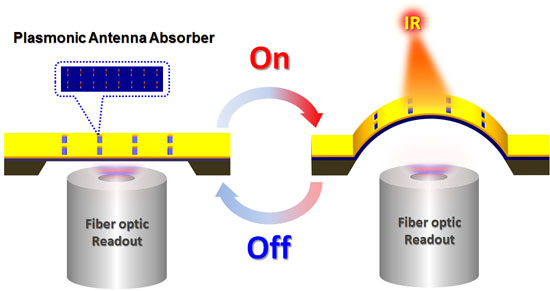| Posted: Apr 17, 2013 | |
Plasmomechanics - an emerging field that combines nanoplasmonics with nanomechanical resonators |
|
| (Nanowerk Spotlight) Nanoplasmonics and nanomechanics have been considered as two disparate fields. However, they both deal with waves of different nature. Nanoplasmonic antennas, or simply nanoantennas, are tiny optical analogs of radio-frequency antennas are resonators for light waves. On the other hand nanomechanical oscillators behave as resonators for acoustic waves. | |
| By integrating optical nanoantennas directly on a nanomechanical resonators, researchers at the University of Pennsylvania have now shown that it is possible to achieve very efficient interactions between light and nanomechanical resonators. This hybrid approach enables novel functionalities in various applications. | |
| Reporting their findings in a recent issue of Nano Letters ("Plasmonically Enhanced Thermomechanical Detection of Infrared Radiation"), a team led by Ertugrul Cubukcu, an Assistant Professor in the Department of Materials Science and Engineering at the University of Pennsylvania, combines nanoplasmonics with nanomechanical resonators – a transformative approach which can lead to optically controlled nanomechanical systems enabling unprecedented functionality in biomolecular and toxic gas sensing and on-chip mass spectroscopy. | |
 |
|
| A schematic describing plasmonically enhanced thermomechanical detection of infrared radiation. (Image: Fei Yi and Ertugrul Cubukcu, University of Pennsylvania) | |
| Nanoantennas are made of metals, which absorb light very efficiently. "This metal absorption has been considered a nuisance in the field of plasmonics and impedes the implementation of plasmonic concepts in practical applications," Cubukcu tells Nanowerk. "However, recently thermal effects induced by strong light absorption in nanoantennas have been investigated; e.g. photothermal cancer therapy. In our device, we utilized our nanoantennas as efficient light absorbers which heats the nanomechanical devices on which the nanoantennas are integrated. This in turn increases the temperature of the integrated device." | |
| To demonstrate a specific example of the platform, Cubukcu's team fabricated a novel room-temperature thermal infrared detector that integrates a nanoplasmonic absorber on a beam type nanomechanical structure with a novel interferometric fiberoptic read-out. This plasmo-thermomechanical device can detect infrared radiation with a performance comparable to the state-of-the-art thermal detectors. | |
| The active structure of the plasmo-thermomechanical infrared detector is a suspended 100 µm by 500 µm gold-silicon nitride bilayer beam integrated with the plasmonic nanoantenna absorber. The bilayer beam consists of a 22 nm thick gold layer with 3 nm of titanium for adhesion on 100 nm of silicon nitride. The plasmonic absorber, embedded in the metal layer, consists of an array of nanoslot antennas etched into the bilayer mechanical beam, which is designed to enhance the absorption of the IR radiation with a spectrum centered around a wavelength λ = 6 µm. Typical nanoslots are 100 nm wide and 1600 nm long. | |
| "Our nanoplasmonic thermomechanical device relies on efficient absorption of infrared radiation by an array of nanoslot antennas as an active component that converts optical power into heat," explains Fei Yi, a postdoc researcher in Cubukcu's group and first author of the paper. "The nanoslot configuration provides the best thermomechanical coupling due to its uniform bilayer material coverage as compared to an array of discrete nanoantenna elements." | |
| The generated heat is then converted to a temperature increase on the integrated nanomechanical bimaterial structure. In response to this temperature increase, the bimaterial nanomechanical beam bends as a result of the differences in the thermal expansion coefficients of the two constituent materials. An integrated fiber-based interferometric readout, which offers the best displacement sensitivity, then converts this mechanical bending into an electrical signal. | |
| The researchers expect this hybrid approach to enable multimodal sensing on the same chip. Nanoantennas sensors can be used as very sensitive optical sensors with potentially single molecule sensitivity. Nanomechanical sensors have also been implemented to achieve single atom mass sensitivity. Combining mass and optical sensors can enable simultaneous measurement of different physical properties of target molecules. Also for infrared sensing typically expensive bulky detectors are used. | |
| "Since our platform offers an integrated infrared detector, it is possible to achieve ultracompact infrared sensing systems on a single chip," concludes Cubukcu. | |
 By
Michael
Berger
– Michael is author of three books by the Royal Society of Chemistry:
Nano-Society: Pushing the Boundaries of Technology,
Nanotechnology: The Future is Tiny, and
Nanoengineering: The Skills and Tools Making Technology Invisible
Copyright ©
Nanowerk LLC
By
Michael
Berger
– Michael is author of three books by the Royal Society of Chemistry:
Nano-Society: Pushing the Boundaries of Technology,
Nanotechnology: The Future is Tiny, and
Nanoengineering: The Skills and Tools Making Technology Invisible
Copyright ©
Nanowerk LLC
|
|
|
Become a Spotlight guest author! Join our large and growing group of guest contributors. Have you just published a scientific paper or have other exciting developments to share with the nanotechnology community? Here is how to publish on nanowerk.com. |
|
